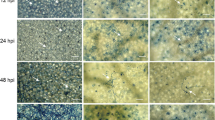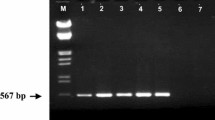Abstract
Cucumis melo accession PI 313970 possesses numerous genes for race-specific resistance to powdery mildew incited by Podosphaera xanthii. It also exhibits resistant blister (RB) leaf reactions, characteristic for non-race-specificity, to several races of P. xanthii in California, U.S.A. Microscopic examination confirmed the presence of mycelia, conidiophores and conidia, and limited number of necrotic cells within and limited to RB tissue. PI 313970 was susceptible to inoculation with Czech isolates of P. xanthii and Golovinomyces cichoracearum on leaf discs. Frequency of conidial germination did not differ between pathogen species, or between PI 313970 and the susceptible cucumber cv. ‘Stela’ control, but number of germ tubes and appressoria, mycelial growth and conidial production of both pathogens through 144 hours post-inoculation were reduced in comparison with the susceptible control. Hypersensitive responses (HR) were not observed in ‘Stela’, but occurred to a limited extent in PI 313970 where = 3% of examined sites had necrotic spots. These responses indicate two different resistance mechanisms to these powdery mildew isolates in PI 313970. The first mechanism targets conidial germination and appressoria formation. The second mechanism reduces pathogen growth and reproduction with minimal or no HR involvement and may be influenced by the first mechanism. Resistant blisters, observed only on intact leaves evidence a third and non-race-specific mechanism to P. xanthii and G.cichoracearum in PI 313970, based on our histological study.
Zusammenfassung
Die Akzession PI 313970 der Melone (Cucumis melo) besitzt zahlreiche rassenspezifische Resistenzgene gegenüber dem durch Podosphaera xanthii verursachten Echten Gurkenmehltau. Sie bildet darüber hinaus blasenförmige, nicht rassenspezifische Resistenzsymptome gegenüber zahlreichen kali- fornischen Rassen dieses Erregers auf den Blättern aus. Mikroskopische Untersuchungen bestätigten das Vorhandensein von Myzel, Konidiophoren und Konidien sowie eine begrenzte und auf das blasenförmig umgewandelte Gewebe beschränkte Anzahl nekrotisierter Zellen. Blattscheiben der Melonenakzession PI 313970 waren änfällig gegenüber tschechischen Isolaten von P. xanthii und des zweiten Erregers des Echten Gurkenmehltaus, Golovinomyces cichoracearum. Die Keimungsraten der Konidien unterschieden sich nicht zwischen den Erregerarten sowie zwischen PI 313970 und der als Kontrolle untersuchten anfälligen Gurkensorte ‘Stela’, aber die Anzahl der Keimschläuche und Appressorien, das Myzelwachstum und die Konidienbildung beider Erreger waren bis 144 Stunden nach der Inokulation gegenüber der anfälligen Kontrolle vermindert. Eine hypersensitive Reaktion wurde bei ‘Stela’ nicht beobachtet, während sie in begrenztem Umfang bei PI 313970 auftrat, wo = 3% der untersuchten Bereiche nekrotische Flecken aufwiesen. Diese Resistenzreaktionen von PI 313970 gegenüber den Erregern des Echten Gurkenmehltaus beruhen auf zwei verschiedenen Mechanismen. Der erste Resistenzmechanismus zielt auf die Konidienkeimung und die Appressorienbildung. Der zweite vermindert Wachstum und Vermehrung der Erreger mit minimaler oder nicht ausgelöster hypersensitiver Reaktion und könnte durch den ersten Mechanismus beeinflusst sein. Blasenförmige Blattveränderungen wurden nicht auf Blattscheiben, sondern nur auf intakten Blättern von PI 313070 mittels histologischer Verfahren beobachtet. Sie deuten auf das Vorhandensein eines dritten, nicht rassenspezifischen Resistenzmechanismus gegenüber P. xanthii und G. cichoracearum in PI 313970 hin.
Similar content being viewed by others
References
Abood, J.K., D.M. Lösel, 2003: Changes in carbohydrate composition of cucumber leaves during the development of powdery mildew infection. Plant Pathol. 52, 256–265.
Adam, L., S. Ellwood, I. Wilson, G. Saenz, S. Xiao, R.P. Oliver, J.G. Turner, S. Somerville, 1999: Comparison of Erysiphe cichoracearum and E. cruciferarum and a survey of 360 Arabidopsis thaliana accessions for resistance to these two powdery mildew pathogens. Mol. Plant-Microbe Interact. 12, 1031–1043.
Bardin, M., J. Carlier, P.C. Nicot, 1999: Genetic differentiation in the French population of Erysiphe cichoracearum, a causal agent of powdery mildew of cucurbits. Plant Pathol. 48, 531–540.
Carver, T.L.W., A.J. Wright, B.J. Thomas, 2002: Initial events in the establishment of cereal powdery mildew infection. Plant Prot. Sci. 38 (Special Issue 1), 65–68.
Cohen, Y., H. Eyal, 1988: Epifluorescence microscopy of Sphaerotheca fuliginea race 2 on susceptible and resistant genotypes of Cucumis melo. Phytopathology 78, 144–148.
Cohen, Y., H. Eyal, J. Hanania, 1990: Ultrastructure, autofluorescence, callose deposition and lignification in susceptible and resistant muskmelon leaves infected with the powdery mildew fungus Sphaerotheca fuliginea. Physiol. Mol. Plant Pathol. 36, 191–204.
Collinge, D.B., P.L. Gregersen, H. Thordal-Christensen, 2002: The nature and role of defense response genes in cereals. In: R.R. BELANGER, W.R. BUSHNELL, A.J. DIK, T.L.W. CARVER (eds.): The Powdery Mildews. A Comprehensive Treatise, pp. 146–160. APS Press, St. Paul, MN, USA.
Floris, E., J.M. Alvarez, 1996: Nature of resistance of seven melon lines to Sphaerotheca fuliginea. Plant Pathol. 45, 155–160.
Goodwin, J.R., J.W. Mansfield, P. Darby, 1987: Microscopical studies of resistance to powdery mildew disease in the hop cultivar Wye Target. Plant Pathol. 36, 21–32.
Green, J.R., T.L.W. Carver, S.J. Gurr, 2002: The formation and function of infection and feeding structures. The Powdery Mildews. A Comprehensive Treatise, pp. 66–82. APS Press, St. Paul, MN, USA.
Hammond-Kosack, K.E., J.D.G. Jones, 1996: Resistance gene-dependent plant defense responses. Plant Cell 8, 1773–1791.
Jabs, T, A.J. Slusarenko, 2000: The hypersensitive response. In: A.J. SLUSARENKO, R.S.S. FRASER, L.C. VAN LOON (eds): Mechanisms of Resistance to Plant Diseases, pp. 279–323. Kluwer Academic Publishers, Dordrecht, the Netherlands.
Jagger, I.C., T.W. Whitaker, D.R. Porter, 1938: A new biologic form of powdery mildew on muskmelons in the Imperial Valley of California. Plant Dis. Rep. 22, 275–276.
Jahn, M., H.M. Munger, J.D. Mccreight, 2002: Breeding cucurbit crops for powdery mildew resistance. The Powdery Mildews. A Comprehensive Treatise, pp. 239–248. APS Press, St. Paul, MN, USA.
Koga, H., W.R. Bushnell, R.J. Zeyen, 1990: Specificity of cell type and timing of events associated with papilla formation and the hypersensitive reaction in leaves of Hordeum vulgare attacked by Erysiphe graminis f.sp. hordei. Can. J. Bot. 68, 2344–2352.
Krístková, E., A. Lebeda, B. SedlakovA, 2004: Virulence of Czech cucurbit powdery mildew isolates on Cucumis melo genotypes MR-1 and PI 124112. Sci. Hortic. 99, 257–265.
Krístková, E., A. Lebeda, B. Sedlakova, 2007: Temporal and spatial dynamics of powdery mildew species on cucurbits in the Czech Republic. Acta Hortic. 731, 337–343.
Kuzuya, M., K. Yashiro, K. Tomita, H. Ezura, 2006: Powdery mildew (Podosphaera xanthii) resistance in melon is categorized into two types based on inhibition of the infection processes. J. Exp. Bot. 57, 2093–2100.
Lebeda, A., 1983: The genera and species spectrum of cucumber powdery mildew in Czechoslovakia. Phytopathol. Z. 108, 71–79.
Lebeda, A., 1984: Screening of wild Cucumis species for resistance to cucumber powdery mildew (Erysiphe cichoracearum and Sphaerotheca fuliginea). Sci. Hortic. 24, 241–249.
Lebeda, A., 1986: Padlí okurkové. Erysiphe cichoracearum, Sphaerotheca fuliginea (Cucumber powdery mildew. Erysiphe cichoracearum, Sphaerotheca fuliginea). In: A. Lebeda (ed.): Methods of Testing Vegetable Crops for Resistance to Plant Pathogens, pp. 87–91. VHJ Sempra, Research Institute of Vegetable Crops, Olomouc, Czechoslovakia.
Lebeda, A., E. Krístková, B. Sedlakova, J.D. Mccreight, M.D. Coffey, 2008: New concept for determination and denomination of pathotypes and races of cucurbit powdery mildew. Cucurbitaceae 2008, Proceedings of the IXth EUCARPIA Meeting on Genetics and Breeding of Cucurbitaceae, INRA, Avignon, France, 21–24 May 2008, 125–133.
Lebeda, A., B. Sedlakova, 2006: Identification and survey of cucurbit powdery mildew races in Czech populations. Proceedings of Cucurbitaceae 2006, Raleigh, North Carolina, USA, 17–21 September 2006, 444–452.
Lebeda, A., B. Sedlakova, E. Krístková, 2007: Temporal changes in pathogenicity structure of cucurbit powdery mildew populations. Acta Hortic. 731, 381–388.
Liyanage, A.D.S., R.A. Neve, D.J. Royle, 1973: Resistance to hop powdery mildew (Sphaerotheca humuli (DC.) Burr). Report of the Department of Hop Research, Wye College 1972, 49–50.
Luhova, L., D. Jancová, I. Frebort, A. Lebeda, M. Šebela, E. Křístková, P. Pec, 1999: Amine oxidase, peroxidase, catalase and acid phosphatase activities in powdery mildew infected plants of Cucumis sativus. Phyton 39, 235–241.
Mccreight, J.D., 2001: Resistant blister reaction to powdery mildew in melon PI 313970 and PI 124111. Cucurbit Genet. Coop. Rep. 24, 22.
Mccreight, J.D., 2003: Genes for resistance to powdery mildew races 1 and 2U.S. in melon PI 313970. Hortscience 38, 591–594.
Mccreight, J.D., 2004: Notes on the change of the causal species of cucurbit powdery mildew in the U.S. Cucurbit Genet. Coop. Rep. 27, 8–23.
Mccreight, J.D., 2006: Melon-powdery mildew interactions reveal variation in melon cultigens and Podosphaeraxanthii races 1 and 2. J. Am. Soc. Hortic. Sci. 131, 59–65.
Mccreight, J.D., M.D. Coffey, T.A. Turini, M.E. Matheron, 2005: Field evidence for a new race of powdery mildew on melon. Hortscience 40, 888.
Mccreight, J.D., M.D. Coffey, 2007: Resistance to a new race of the cucurbit powdery mildew present in Arizona and California. Hortscience 42, 1013.
Mieslerová, B., A. Lebeda, R. Kennedy, 2004: Variation in Oidium neolycopersici development on host and non-host plant species and their tissue defence responses. Ann. Appl. Biol. 144, 237–248.
Pitrat, M., D. Besombes, 2008: Inheritance of Podosphaera xanthii resistance in melon line ‘90625’. Cucurbitaceae 2008, Proceedings of the IXth EUCARPIA Meeting on Genetics and Breeding of Cucurbitaceae, INRA, Avignon, France, 21–24 May 2008, 135–142.
Pitrat, M., C. Dogimont, M. Bardin, 1998: Resistance to fungal diseases of foliage in melon. Proceedings, Cucurbitaceae ’98: Evaluation and enhancement of cucurbit germplasm, Alexandria, Virginia, USA, 167–173.
Robinson, R.W., D.S. Decker-Walters, 1997: Cucurbits. CAB International, New York, USA.
Romero, D., M. Eugenia Rivera, F.M. Cazorla, J.C. Codina, D. Fernández-Ortuño, J.A. Torés, A. Pérez-García, A. de Vicente, 2008: Comparative histochemical analyses of oxidative burst and cell wall reinforcement in compatible and incompatible melon-powdery mildew (Podosphaera fusca) interactions. J. Plant Physiol. 165, 1895–1905.
Royle, D.J., 1978: Powder y mildew of the hop. In: D.M. SPENCER (ed.): The powdery mildews, pp. 381–409. Academic Press, New York, USA.
Salmon, E.S., 1917: On the resistance to fungicides shown by the hop-mildew (Sphaerotheca humuli (D.C.) Burr.) in different stages of development. Ann. Appl. Biol. 1, 93–96.
Salmon, E.S., 1919: On forms of the hop (Humulus lupulus L.) resistant to mildew ((Sphaerotheca humuli (D.C.) Burr.). J. Agric. Sci. 8, 455–460.
Smith, J.M., 2005: Powdery mildew (Podosphaera macularis Braun & Takamatsu) resistance in wild hop genetic resources. M.Sc. thesis, Oregon State University.
Thomas, C.E., 1986: Downy and powdery mildew resistant muskmelon breeding line MR-1. Hortscience 21, 329.
Vakalounakis, D.J., E. Klironomou, A. Papadakis, 1994: Species spectrum, host range and distribution of powdery mildews on Cucurbitaceae in Crete. Plant Pathol. 43, 813–818.
Zar, J.H., 1996: Biostatistical Analysis. Prentice Hall, London, UK.
Author information
Authors and Affiliations
Corresponding author
Rights and permissions
About this article
Cite this article
Sedlá, M., Lebeda, A., Mikšíková, P. et al. Histological aspects of Cucumis melo PI 313970 resistance to Podosphaera xanthii and Golovinomyces cichoracearum. J Plant Dis Prot 116, 169–176 (2009). https://doi.org/10.1007/BF03356306
Received:
Accepted:
Published:
Issue Date:
DOI: https://doi.org/10.1007/BF03356306
Key words
- cucurbit powdery mildew
- histopathological changes
- infection structures
- melon
- resistance mechanisms
- resistant blister symptom




